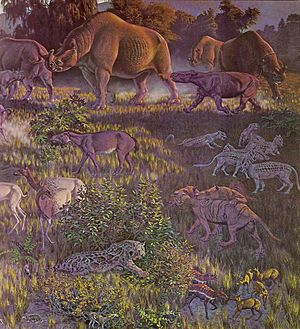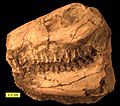Oligocene facts for kids
The Oligocene was a time in Earth's history. It was a geological epoch, which is a very long period of time. It lasted for about 11 million years, from 34 million years ago (mya) to 23 mya. The Oligocene came after the Eocene epoch and before the Miocene epoch.
During the Oligocene, the world became much cooler. This cooling trend started after the very warm Eocene period. Even though it was cooler, much of the Earth was still covered in forests. However, new areas of grasslands began to spread across the land. For the first time, Ice started to form in Antarctica. This period was a time of big changes for both the climate (weather patterns) and the biota (living things).
Contents
What Was the Oligocene Epoch?
The Oligocene is part of a larger time called the Palaeogene period. It is the last epoch of the Palaeogene. Scientists study rocks and fossils to learn about this time. They can tell how long ago events happened by looking at different rock layers.
Climate and Environment
The Earth's climate changed a lot during the Oligocene. It continued to get cooler after the Eocene. This cooling led to some important changes around the world.
- Ice Caps Grow: For the first time, large ice sheets started to form in Antarctica. This was a big step towards the ice ages we know today.
- Forests Change: While forests were still common, they began to shrink in some areas. This made room for new types of environments.
- Grasslands Appear: One of the most important changes was the spread of grasslands. These open areas were perfect for new kinds of grazing animals.
Ocean Changes
The cooling climate also affected the oceans. Ocean currents changed as continents moved. This helped to spread cooler water around the globe. These changes impacted marine life, too.
Amazing Animals of the Oligocene
The Oligocene was a time of great change for animals. Many new types of mammals appeared and spread. Some older groups of animals became less common.
Mammals Take Over
Mammals became the main large land animals during the Oligocene. They grew bigger and more diverse.
- Giant Rhinos: One of the largest land mammals ever lived during this time. It was called Paraceratherium. It was a giant, long-necked rhino that ate leaves from tall trees.
- Early Horses: Animals like Mesohippus were early relatives of modern horses. They were smaller than today's horses and had three toes on each foot. They lived in the spreading grasslands.
- Ancient Camels: Poebrotherium was an early camel. It was much smaller than modern camels and lived in North America.
- False Saber-toothed Cats: Predators like Hoplophoneus looked like saber-toothed cats but were not closely related. They had long, sharp teeth for hunting.
- Oreodonts: Animals like Merycoidodon were very common in North America. They were plant-eaters that looked a bit like pigs or sheep.
- Early Whales: In the oceans, early whales continued to evolve. Some, like Janjucetus, were toothed whales.
Other Animals
Besides mammals, other animals also thrived.
- Birds: Many types of birds were present, including large flightless birds.
- Reptiles: Crocodiles and turtles were still common in warmer regions.
- Marine Life: The oceans were home to many fish, sharks, and early seals. Paleoparadoxia was a marine mammal that looked a bit like a large sea cow.
Images for kids
-
Neotethys during the Oligocene (Rupelian, 33.9–28.4 mya)
See also
 In Spanish: Oligoceno para niños
In Spanish: Oligoceno para niños













